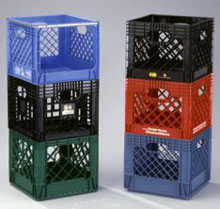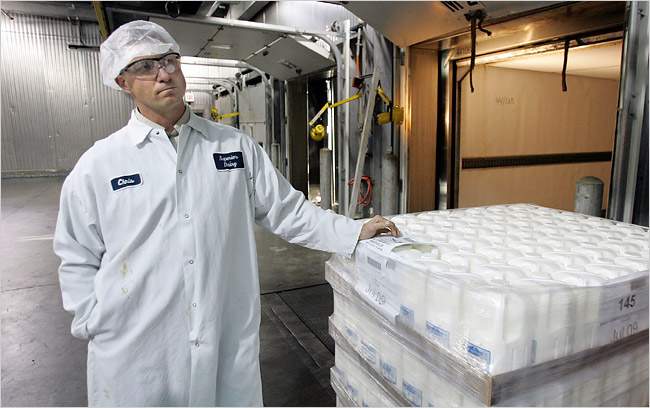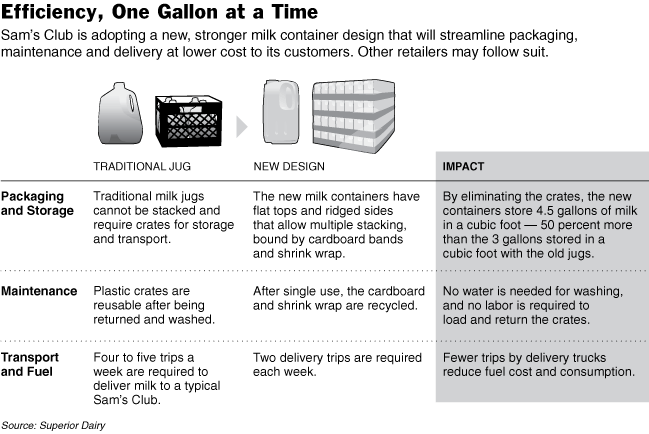What happened to my jugs? They’re huge! I’m talking about my milk jugs, of course. No, seriously -- those large, plastic, gallon-sized jugs that you buy at the store that are filled with milk. It seems that they’ve gone through quite a growth spurt all of the sudden.
Why the sudden design change? Transitioning to the new “squared off” jugs saves money, materials, time, and fuel… all things that are good for businesses, consumers, and the environment. The new-fangled jugs started showing up in selected Costco, WalMart, and Sam’s Club stores last fall. But because of the savings they represent, they are certain to start appearing in grocery stores all around the country before long.
So what exactly makes these new jugs so special? It becomes clear once you compare how we’ve “always done things” with the new process that utilizes this new design. The traditional milk jugs that we are all used to are transported using plastic milk crates. (If you’ve been in a college dorm, you’ve no doubt seen these – they make handy shelves and furniture for those individuals on a college budget. Sometimes they tend to “disappear” from the alleyways behind grocery stores in college towns -- not that I have any personal experience in this area. Ahem.)

The crates are necessary because the shape of old-fashioned milk jugs prohibits stacking them atop one another. The crates take up a lot of room, they are unwieldy to move, and extra space must be left in delivery trucks to take empty ones back from stores to the dairy.
They also can be filthy. “Birds roost on them,” said Dan Soehnlen, president of Superior Dairy. He spoke while standing in pools of the soapy run-off from milk crates that had just been washed. About 100,000 gallons of water a day are used at his dairy clean the crates. (1)
But with the new jugs, the milk crates are gone. Instead, a machine stacks the jugs, with cardboard sheets between layers. Then the entire pallet, four layers high, is shrink-wrapped and moved with a forklift.

The company estimates this kind of shipping has cut labor by half and water use by 60 to 70 percent. More gallons fit on a truck and in Sam’s Club coolers, and no empty crates need to be picked up, reducing trips to each Sam’s Club store to two a week, from five — a big fuel savings. Also, Sam’s Club can now store 224 gallons of milk in its coolers, in the same space that used to hold 80.
The whole operation is so much more efficient that milk coming out of a cow in the morning winds up at a Sam’s Club store by that afternoon, compared with several hours later or the next morning by the old method. Not only that, but as a result of all of these savings, milk is cheaper as well – on average 10 to 20 cents a gallon. In an age where milk and gas are battling it out to see which can claim a higher price per gallon, I’m happy to see a price drop for either.

The major drawback of the new jugs however, may not be realized until you get them back to your kitchen. While the production efficiencies gained by the new design are hard to dispute, the benefits are tainted a bit by the unwieldy nature of the jugs when it comes to using them for what they’re ultimately designed for – pouring milk.
The jugs have a large mouth that the milk is poured out of, and no real “spout” to help direct the flow. As a result, first-time users of the new jugs often end up with a sloppy mess on their countertop.
As with all things though, it just takes a little practice and patience. The name of the game is slow and easy. Because the jugs are larger and bulkier, it’s prudent to try tipping them to pour the milk -- especially when they are fairly full. Bring the glass up to the opening of the jug instead of the other way around, and you’ll go through fewer clean-ups in the kitchen.
So is the new design worth the mess? I think so. I can adapt to a milk jug that takes a little more finesse if it means there is material, fuel, and cost savings to be had. As long as I’ve got a “tall, cool one” to accompany my chocolate cake, I’ll embrace a change that gets it there in a more environmentally favorable fashion.
NOTES:





Comments